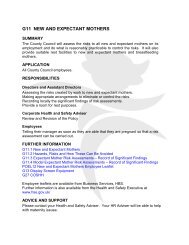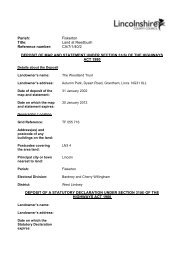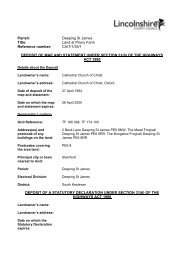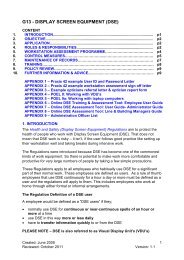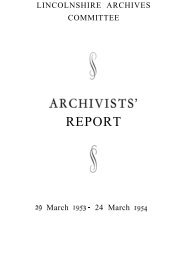Dignity at Work - Policy and Procedure
Dignity at Work - Policy and Procedure
Dignity at Work - Policy and Procedure
You also want an ePaper? Increase the reach of your titles
YUMPU automatically turns print PDFs into web optimized ePapers that Google loves.
Employment Manual<br />
DIGNITY AT WORK<br />
POLICY AND<br />
PROCEDURE<br />
The County Council is committed to cre<strong>at</strong>ing an<br />
environment <strong>at</strong> work where there is universal dignity <strong>and</strong><br />
respect:<br />
• between employees of the County Council<br />
• of County Council employees by people not<br />
employed by the Council.<br />
This document applies to all County Council employees except<br />
in schools, however the principles can be adopted in schools.<br />
(NB. School employees have access to the County Council's<br />
Harassment Advisers.)<br />
The Chief Executive <strong>and</strong> Corpor<strong>at</strong>e Directors, for whom<br />
separ<strong>at</strong>e arrangements exist.
DIGNITY AT WORK<br />
CONTENTS TABLE<br />
OBJECTIVES ..................................................................................................................2<br />
PRINCIPLES ...................................................................................................................2<br />
RESPONSIBILITIES .......................................................................................................2<br />
CHIEF EXECUTIVE AND DIRECTORS ......................................................................2<br />
MANAGERS ................................................................................................................3<br />
ASSISTANT DIRECTOR - PEOPLE AND MODERNISATION ....................................3<br />
EMPLOYEES...............................................................................................................3<br />
DEFINITIONS..................................................................................................................3<br />
HARASSMENT............................................................................................................3<br />
DISCRIMINATION .......................................................................................................3<br />
BULLYING ...................................................................................................................4<br />
VICTIMISATION ..........................................................................................................4<br />
IMPLICATIONS ...............................................................................................................4<br />
LEGISLATION.................................................................................................................4<br />
FURTHER INFORMATION .............................................................................................5<br />
ADVICE AND SUPPORT ................................................................................................5<br />
APPENDIX 1 FLOWCHART OF PROCEDURES ...........................................................6<br />
OBJECTIVES<br />
To protect all employees from harassment, discrimin<strong>at</strong>ion, bullying <strong>and</strong> victimis<strong>at</strong>ion by:<br />
• cre<strong>at</strong>ing an environment where everyone is tre<strong>at</strong>ed with respect <strong>and</strong> dignity<br />
• having procedures which protect all employees from harassment, discrimin<strong>at</strong>ion,<br />
bullying <strong>and</strong> victimis<strong>at</strong>ion <strong>at</strong> work wherever possible<br />
• having procedures to deal effectively with any complaints <strong>at</strong> work<br />
PRINCIPLES<br />
Any form of harassment, discrimin<strong>at</strong>ion, bullying <strong>and</strong> victimis<strong>at</strong>ion is unacceptable.<br />
All employees have the right to:<br />
• complain about harassment, discrimin<strong>at</strong>ion, bullying <strong>and</strong> victimis<strong>at</strong>ion <strong>at</strong> work<br />
• have their complaints taken seriously<br />
• have their complaints dealt with properly <strong>and</strong> in confidence<br />
• receive support <strong>and</strong> help from the County Council<br />
RESPONSIBILITIES<br />
CHIEF EXECUTIVE AND DIRECTORS<br />
Effective implement<strong>at</strong>ion of the policy.<br />
Monitoring the arrangements <strong>and</strong> practices.<br />
Ensuring the appointment of an appropri<strong>at</strong>e number of employees to act as<br />
Harassment Advisers.<br />
Keeping confidential records of complaints made <strong>and</strong> investig<strong>at</strong>ions.<br />
Ensuring th<strong>at</strong> employees have inform<strong>at</strong>ion on dignity <strong>at</strong> work.
MANAGERS<br />
Ensuring th<strong>at</strong> all complaints from any member of staff are taken seriously <strong>and</strong> acted<br />
upon promptly.<br />
Ensuring th<strong>at</strong> employees underst<strong>and</strong> wh<strong>at</strong> harassment, discrimin<strong>at</strong>ion, bullying <strong>and</strong><br />
victimis<strong>at</strong>ion is, <strong>and</strong> th<strong>at</strong> it is unacceptable <strong>and</strong> th<strong>at</strong> action will be taken against its<br />
perpetr<strong>at</strong>ors.<br />
Setting an example through their own behaviour towards employees.<br />
Making the list of Harassment Advisers easily available, e.g. through a notice board, <strong>at</strong><br />
induction.<br />
Giving inform<strong>at</strong>ion about the Employee Support <strong>and</strong> Counselling Service, which will<br />
provide confidential <strong>and</strong> impartial advice.<br />
Ensuring th<strong>at</strong> the leaflet "<strong>Dignity</strong> <strong>at</strong> <strong>Work</strong> – Employee Guidelines” is available to all<br />
employees <strong>and</strong> new starters.<br />
ASSISTANT DIRECTOR - PEOPLE AND MODERNISATION<br />
Provision of training <strong>and</strong> support for Harassment Advisers.<br />
Co-ordin<strong>at</strong>ion of the Medi<strong>at</strong>ion Service<br />
Review <strong>and</strong> revision of the policy.<br />
EMPLOYEES<br />
Ensuring th<strong>at</strong> they do not harass, discrimin<strong>at</strong>e, bully or victimise others. Breaches of<br />
this duty will be dealt with under the Disciplinary <strong>Procedure</strong>.<br />
DEFINITIONS<br />
HARASSMENT<br />
Harassment is when someone considers th<strong>at</strong> th<strong>at</strong> they have been tre<strong>at</strong>ed in a way th<strong>at</strong><br />
is detrimental to their dignity <strong>at</strong> work. Essentially it is tre<strong>at</strong>ment th<strong>at</strong> somebody else<br />
finds unreasonable <strong>and</strong> unwelcome <strong>and</strong> which causes intimid<strong>at</strong>ion <strong>and</strong> offence.<br />
Although it may involve overt abuse of power, bullying, coercion or violence, it can<br />
often appear in more subtle forms <strong>and</strong> can be unintentional.<br />
Harassment can be a single act or numerous acts which are ongoing.<br />
DISCRIMINATION<br />
Discrimin<strong>at</strong>ion is about less favourable tre<strong>at</strong>ment on the grounds of sex, sexual<br />
orient<strong>at</strong>ion, race or origin, marital st<strong>at</strong>us, civil partnership st<strong>at</strong>us, disability, age, or any<br />
other characteristic an individual may identify with.<br />
It can also be about someone else's religion or sexual orient<strong>at</strong>ion other than the<br />
employee e.g. an employee may be subject to harassment because his son is gay.<br />
This may be harassment on the grounds of sexual orient<strong>at</strong>ion, despite it not being the<br />
employees own sexuality th<strong>at</strong> is the subject of the harassment.
Harassment can also occur where, for a reason, which rel<strong>at</strong>es to a person’s disability<br />
another person engages in unwanted conduct, e.g. an employee with a learning<br />
disability is called ‘stupid’ <strong>and</strong> ‘slow’ by a colleague <strong>at</strong> work. This may be harassment<br />
on the grounds of disability, whether or not the disabled employee was present when<br />
the comments were made, because they were said with the intention of humili<strong>at</strong>ing<br />
them.<br />
BULLYING<br />
Bullying is offensive, intimid<strong>at</strong>ing, malicious or insulting behaviour, an abuse or misuse<br />
of power through means which undermine, humili<strong>at</strong>e, denigr<strong>at</strong>e or injure the individual<br />
or a group of employees. This kind of conduct is usually sustained.<br />
Examples of bullying are:<br />
• shouting <strong>at</strong> an employee in front of others<br />
• sarcastic comments deliber<strong>at</strong>ely aimed <strong>at</strong> the individual<br />
• ridiculing someone or deliber<strong>at</strong>ely setting them up to fail<br />
• overbearing supervision or other misuse of power or position<br />
• making thre<strong>at</strong>s about job security without found<strong>at</strong>ion<br />
• undermining a competent worker by overloading <strong>and</strong> constant criticism<br />
VICTIMISATION<br />
Victimis<strong>at</strong>ion is less favourable tre<strong>at</strong>ment as a result of having taken action against the<br />
organis<strong>at</strong>ion or an employee within the organis<strong>at</strong>ion.<br />
Examples of victimis<strong>at</strong>ion are:<br />
• ignoring someone or not offering them a post because they previously raised a<br />
complaint through any of the Council’s procedures<br />
• blocking opportunities e.g. training or progression because they have previously<br />
complained<br />
IMPLICATIONS<br />
Harassment, victimis<strong>at</strong>ion, bullying or discrimin<strong>at</strong>ion can lead to illness, absence from<br />
work, an apparent lack of commitment, poor performance <strong>and</strong> resign<strong>at</strong>ion. The results<br />
include:<br />
• poor morale<br />
• employees resigning, including potential claims for unfair dismissal<br />
• lower efficiency<br />
• divided teams<br />
LEGISLATION<br />
The County Council’s <strong>Dignity</strong> <strong>at</strong> <strong>Work</strong> <strong>Policy</strong> supplements the right of an employee to<br />
seek legal redress for harassment <strong>and</strong>/or discrimin<strong>at</strong>ion through the relevant<br />
legisl<strong>at</strong>ion. A summary of the legisl<strong>at</strong>ion th<strong>at</strong> may apply is given below.<br />
Sex Discrimin<strong>at</strong>ion Act 1975<br />
Race Rel<strong>at</strong>ions Act 1976<br />
Disability Discrimin<strong>at</strong>ion Act 1995<br />
Sex Discrimin<strong>at</strong>ion (Gender Reassignment) Regul<strong>at</strong>ions 1999<br />
Disability Discrimin<strong>at</strong>ion Act 1995 (Amendment) Regul<strong>at</strong>ions 2003<br />
Employment Equality (Religion or Belief) Regul<strong>at</strong>ions 2004<br />
Employment Equality (Sexual Orient<strong>at</strong>ion) Regul<strong>at</strong>ions 2004<br />
Civil Partnership Act (2004)
Employment Equality (Age) Regul<strong>at</strong>ions 2006<br />
Under the Criminal Justice <strong>and</strong> Public Order Act 1994 it is an offence to intentionally<br />
cause a person harassment, alarm or distress. This is where someone:<br />
• uses thre<strong>at</strong>ening, abusive or insulting words or behaviour, or disorderly behaviour<br />
• displays any visible represent<strong>at</strong>ion which is thre<strong>at</strong>ening, abusive or insulting<br />
Under the Protection from Harassment Act 1997 it is an offence for someone to:<br />
• behave in a way which they know, or ought to have known, causes another to fear<br />
the use of violence against them<br />
• behave in a way which they know, or ought to have known, causes another<br />
harassment<br />
Employees alleging harassment <strong>at</strong> work can complain to the Police. Managers should<br />
also consider this where there is evidence to suggest criminal action.<br />
Employers may be liable for wh<strong>at</strong> employees do during their employment, whether or<br />
not the employer knows of those acts. Employers can avoid a successful claim of<br />
unlawful discrimin<strong>at</strong>ion only if they can show th<strong>at</strong> they took reasonable steps to prevent<br />
the offence being committed.<br />
FURTHER INFORMATION<br />
<strong>Dignity</strong> <strong>at</strong> <strong>Work</strong> - Management Guidelines<br />
<strong>Dignity</strong> <strong>at</strong> <strong>Work</strong> - Employee Guidelines<br />
Harassment Advisers<br />
Grievance <strong>Procedure</strong><br />
Equality <strong>and</strong> Diversity <strong>Policy</strong><br />
G15 Violence <strong>at</strong> <strong>Work</strong> <strong>Policy</strong><br />
Access to Personal Inform<strong>at</strong>ion<br />
Confidential Reporting Code<br />
ADVICE AND SUPPORT<br />
Please contact Human Resources.
APPENDIX 1 FLOWCHART OF PROCEDURES<br />
PROCEDURES FOR DEALING WITH AN INCIDENT OF HARASSMENT,VICTIMISATION, BULLYING, DISCRIMINATION OR<br />
VIOLENCE AT WORK<br />
HARASSMENT, VICTIMISATION, BULLYING OR<br />
DISCRIMINATION<br />
Employee/Employee Non employee/Employee 1<br />
Follow advice in documents:<br />
<strong>Dignity</strong> <strong>at</strong> <strong>Work</strong> or<br />
Grievance <strong>Procedure</strong><br />
Use of:<br />
Harassment Advisers<br />
Employee Support <strong>and</strong> Counselling<br />
Service<br />
Medi<strong>at</strong>ion Service<br />
(subject to employee wishes)<br />
May lead to<br />
VIOLENCE AT WORK<br />
Employee/Employee Non employee/Employee<br />
↓ ↓ ↓ ↓<br />
Follow advice in document:<br />
<strong>Dignity</strong> <strong>at</strong> <strong>Work</strong><br />
Follow advice in documents:<br />
G15 Violence <strong>at</strong> <strong>Work</strong><br />
G4 Accident Reporting <strong>Procedure</strong><br />
Grievance <strong>Procedure</strong><br />
Follow advice in document:<br />
G15 Violence <strong>at</strong> <strong>Work</strong><br />
G4 Accident Reporting <strong>Procedure</strong><br />
↓ ↓ ↓ ↓<br />
Use of:<br />
Harassment Advisers<br />
Employee Support <strong>and</strong> Counselling<br />
Service<br />
Medi<strong>at</strong>ion Service<br />
(subject to employee wishes)<br />
Use of:<br />
Employee Support <strong>and</strong> Counselling<br />
Service<br />
(subject to employee wishes)<br />
Use of:<br />
Employee Support <strong>and</strong> Counselling<br />
Service<br />
(subject to employee wishes)<br />
↓ ↓ ↓ ↓<br />
Use of Disciplinary <strong>Procedure</strong> Possible legal action/other<br />
Use of disciplinary procedure<br />
Possible legal action/other<br />
management action<br />
management action<br />
↓ ↓ ↓<br />
Possible legal action/other<br />
Possible legal action/other management<br />
management action<br />
action<br />
Harassment should be tre<strong>at</strong>ed as ‘violence <strong>at</strong> work’ when<br />
it falls within the definition of violence <strong>at</strong> work*<br />
1 E.g. Service user, Elected Member, employee of a contractor providing County Council Services<br />
Definition Any incident where employees are physically or verbally abused,<br />
thre<strong>at</strong>ened or intimid<strong>at</strong>ed or where their property or personal belongings, or<br />
both, are damaged.






